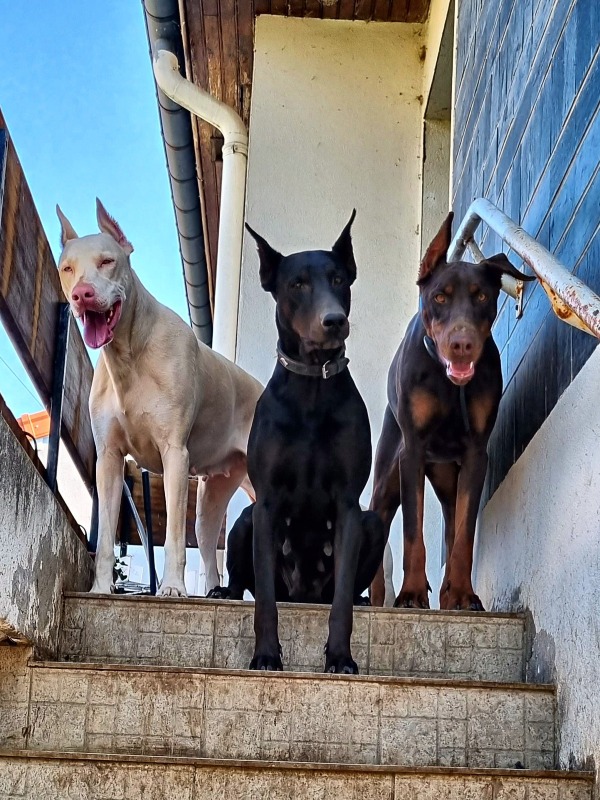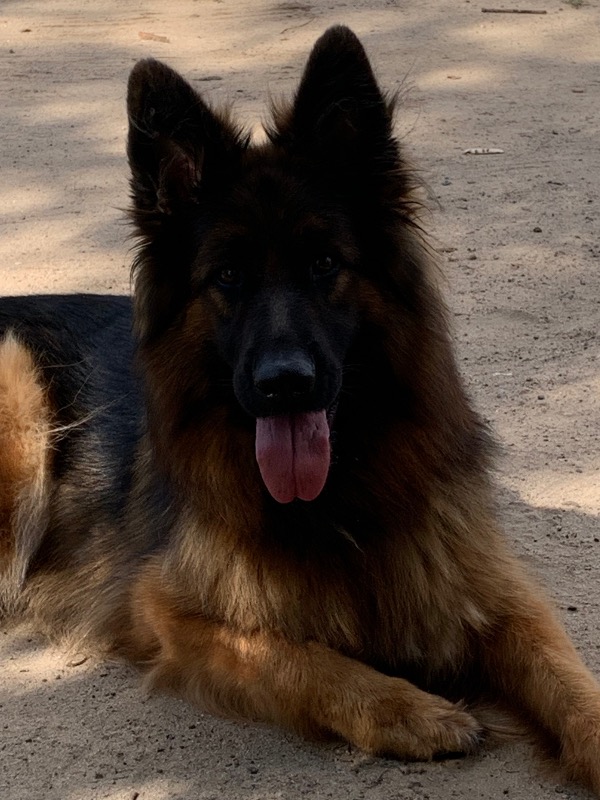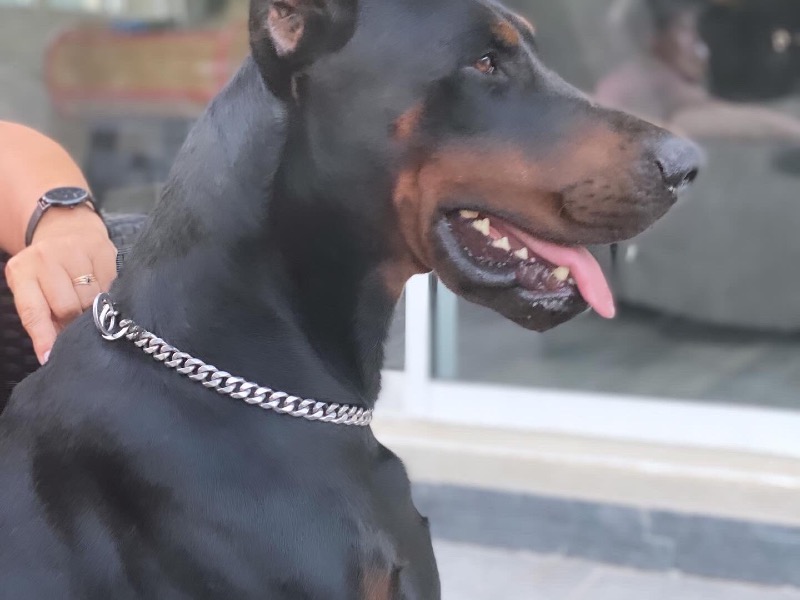Dobermann
Welcome to our page dedicated to the breed of dog dobermann!
Here, you will find all the useful information about dobermann. This descriptive profile will allow you to discover the aspects of this breed. You can notably consult information about the average price, monthly and annual upkeep expenses, their health, name ideas, as well as their official recognition by competent authorities.
Explore this page to discover everything you need to know.
Overall description of the breed
The breed was developed by a German dog breeder known as Frederick Louis Doberman (1834-1894), who lived in Thuringia, a state in east-central Germany known for its extensive forests, mountain peaks and medieval villages.
The breed appeared between 1850 and 1870, the aim of this dog expert was to create a defence dog different from the others, combining multiple qualities of guarding, such as courage, boldness, all associated with an exceptional bite. The Dobermann is the result of several crosses between the Rottweiller, the Pinscher, the Weimar Hound and the Beauce Sheepdog, with which it retains many similarities. Various breeds of sheepdog were also introduced to strengthen its foundations.
The Dobermann was officially recognised by the International Cynological Federation on 1 January 1955, the latest update of the official standard in force was published on 13 November 2015.
Known as the "Gendarme Dog", the Dobermann is an excellent watchdog and a remarkable companion. Its protective instinct is extremely well developed, always attentive to its environment, its territorial temperament makes it an efficient sentinel.
Dissuasive thanks to its singular physique, but especially its easily recognizable virile look, it is one of the large dogs, its body is short, compact, associated with a strongly developed musculature. His topline is clean, firm, slightly sloping from the withers to the loins, his chest is broad and deep, all supported by powerful legs. The head is long and in proportion to the rest of the body. The Doberman's coat is short, close and dense, always black or brown with tan markings on legs, chest and head.
The character of the Doberman is gentle and affectionate with its family, very attached to its social group, its reputation as a mean dog is often wrongly given, as it is a balanced, intelligent and benevolent breed. Remarkably dynamic, they will appreciate playtime as well as educational activities. They are ingenious and will surprise you with their learning abilities as well as their mischief. At ease indoors and outdoors, his docile nature will allow him to easily channel himself within his home, only if a strict education is done in this sense.
His exceptional guarding qualities precede him, particularly distrustful of strangers, he is never aggressive without good reason. Loyal and faithful, the Dobermann is an outstanding companion, who will demonstrate his courage in all circumstances, a true reliable partner who will face any situation.
Adult: The Doberman will weigh approximately 88-99 lbs for males and 70.5-77 lbs for females, with a height at the withers of approximately 26.7-28.3" for males and 24.8-26.7" for females.
Awareness of acquiring an animal
Each animal is a sensitive being, deserving love, attention and care.
When you choose to adopt an animal, you take on the responsibility of ensuring its health and well-being throughout its life.
To learn more about animal welfare, we invite you to consult our FAQ by clicking the button below:
Origins
The Dobermann is a breed of dog created in the late 19th century in Germany by Karl Friedrich Louis Dobermann, hence its name. Karl, who was a tax collector, sought to develop a breed of dog that was both protective and loyal to accompany him on his often perilous travels. To achieve this goal, he crossed various breeds, including the Rottweiler, the German Pinscher, the Weimaraner, and the Manchester Terrier. The result was an elegant, powerful, and loyal dog, capable of effectively protecting its master while being a devoted companion. Since then, the Dobermann has been recognized for its qualities as a guard and working dog.
History
The history of the Dobermann begins in Germany, where Karl Friedrich Louis Dobermann, a tax collector, wanted to create an ideal guard dog. At the end of the 19th century, he used various breeds to develop a powerful, intelligent, and loyal dog. The mix of Rottweiler, German Pinscher, Weimaraner, and Manchester Terrier led to the creation of the Dobermann as we know it today. The breed quickly gained popularity for its qualities as a working and protection dog. Over the decades, the Dobermann has been used in various functions, including as a police, military, and search and rescue dog, while also becoming a beloved companion for families.
Standard
The Dobermann breed standard is defined by several distinctive characteristics. Males measure between 68 and 72 cm at the withers, while females measure between 63 and 68 cm. Their weight ranges from 40 to 45 kg for males and from 32 to 35 kg for females. The Dobermann has an elegant and athletic appearance, with a muscular and well-proportioned body. Its head is long and narrow, with dark almond-shaped eyes. The ears are traditionally cropped and erect, although this practice is increasingly being abandoned in favor of a natural appearance. The tail is typically docked. The coat is short, smooth and tight, providing minimal protection against the weather.
Physical characteristics
The Doberman is a medium to large-sized dog, characterized by an elegant and athletic silhouette. Males measure between 68 and 72 cm at the withers and weigh between 40 and 45 kg, while females measure between 63 and 68 cm and weigh between 32 and 35 kg. Their coat is short, smooth and dense, offering little protection against the weather. The most common coat colors are black and tan, and brown and tan, with well-defined markings on the muzzle, chest, legs, and under the tail. The Doberman has a long and narrow head, almond-shaped dark eyes, and ears that are often cropped and erect.
Character
The Doberman is known for its loyal, protective, and intelligent character. It is a dog very attached to its family and devoted to its master. It is naturally protective and makes an excellent guard dog. Although courageous and determined, it is also sensitive and needs gentle but firm training. The Doberman is an energetic dog that requires regular mental and physical stimulation to prevent boredom and destructive behaviors. With proper socialization from a young age, it can be friendly and sociable with strangers and other animals. Its intelligence and desire to please make it an excellent candidate for obedience and canine sports.
Life expectancy
The average life expectancy of a Doberman is 10 to 13 years. Like all breeds, this can vary depending on various factors such as genetics, lifestyle, and care provided. To maximize their lifespan, it is crucial to offer them a balanced diet, regular exercise, and appropriate veterinary care. Dobermans are prone to developing certain genetic health conditions, such as dilated cardiomyopathy and von Willebrand's disease, which can affect their life expectancy. Regular check-ups with a veterinarian and special attention to their health help to detect and treat these problems early.
Exercise and activity needs
The Doberman is a very active breed that requires a significant amount of daily exercise to maintain its physical and mental health. It is recommended to offer at least one to two hours of activity per day, including walks, runs, and interactive games. The Doberman excels in dog sports such as agility, canicross, and obedience, which stimulate both its body and mind. Due to its energy and intelligence, it is important to vary activities to avoid boredom and destructive behaviors. A well-exercised Doberman is a happy and balanced dog, ready to meet the needs of its family.
Recommended diet
The diet of a Doberman must be balanced and rich in nutrients to support its high activity level and muscle mass. A premium quality diet, tailored to its size, age, and activity level, is essential. It is recommended to feed a Doberman with high-protein kibble, vegetables, and whole grains. An adult Doberman typically consumes between 300 and 500 grams of kibble per day, divided into two meals. The monthly cost of feeding can range between 50 and 100 euros, depending on the quality of the chosen products. Clean, fresh water should always be available to prevent dehydration.
Training and obedience
The Doberman is a very intelligent and eager to please dog, making it an ideal candidate for training. Early socialization and firm but positive education are essential for developing balanced behavior. Positive reinforcement, based on rewards and encouragement, works particularly well with this breed. Dobermans excel in obedience, agility, and other canine sports, and are often used in working roles such as protection, search, and rescue. Consistent and regular training helps to channel their energy and intelligence, making them reliable and well-balanced companions.
Behavior with children
The Doberman can be an excellent companion for children, provided they are well socialized and trained. Due to their protective nature, they often watch over the younger members of the family. However, due to their size and energy, it is important to monitor interactions with very young children to prevent unintentional accidents. Children should be taught to respect the dog and interact with him in an appropriate manner. With proper supervision and positive training, the Doberman can develop an affectionate and protective relationship with children, contributing to a harmonious family environment.
Compatibility with Other Animals
The compatibility of the Doberman with other pets largely depends on their socialization and training. With early and proper socialization, the Doberman can peacefully coexist with other dogs and pets. However, due to their protective instinct and strong personality, it is essential to introduce new animals in a controlled and gradual manner. Initial supervision and positive interactions are crucial to prevent any aggressive or dominant behavior. In general, a well-socialized and trained Doberman can live harmoniously with other animals, but each dog is unique and may react differently based on their temperament.
Grooming needs
The Dobermann has a short and smooth coat, which makes grooming relatively simple. A weekly brushing is usually enough to remove dead hair and maintain the shine of its coat. During shedding periods, more frequent brushing may be necessary. Baths are only necessary when it is particularly dirty or smelly, using gentle shampoos suitable for dogs. It is also important to regularly check and clean its ears to prevent infections. Nails should be trimmed periodically to prevent them from becoming too long and uncomfortable. Good oral hygiene, including brushing teeth, helps prevent dental problems.
Health
The Dobermann is generally a robust breed, but is susceptible to certain hereditary health conditions. Among the most common health problems are dilated cardiomyopathy, a heart disease that can be fatal, and von Willebrand's disease, a blood clotting disorder. Hip and elbow dysplasia, as well as skin problems, can also occur. Regular check-ups with the veterinarian, including cardiac exams and genetic tests, are crucial for detecting and treating these problems as early as possible. A balanced diet, regular exercise, and special attention to preventive care help maintain the health and well-being of the Dobermann.
Average price
The price of a Doberman can vary considerably depending on various factors such as pedigree, breeder reputation, and location. On average, a quality Doberman puppy can cost between 1,000 and 2,500 euros. Dobermans from champion lines or reputable breeders can fetch much higher prices, often exceeding 3,000 euros. It is important to choose a reputable breeder who tests the parents for hereditary diseases and ensures proper socialization of the puppies. In addition to the initial cost, owners should also budget for ongoing expenses for food, veterinary care, and training.
Expenses
Monthly expenses for a Doberman can vary depending on several factors, such as food, veterinary care, and general maintenance. On average, costs can range between 100 and 200 euros per month. This includes quality food (50 to 100 euros), preventive veterinary care, parasite treatments, toys, and various accessories. Grooming costs are relatively low but need to be taken into account. Additional expenses may occur for training, obedience classes, and pet health insurance. It is essential to budget well to ensure the ongoing well-being of your Doberman.
Name ideas
Choosing a name for a Doberman can reflect its nobility and dynamic character. Here are some suggestions: Zeus, Athena, Thor, Hera, Max, Bella, Rocky, Luna, Duke, Rex, Zara, Axel, Ruby, Titan, Nova. These names evoke strength, beauty, and grandeur, typical characteristics of Dobermans. The choice of a name can also be influenced by the individual personality of the dog, its distinctive traits, or even the owner's cultural preferences. A meaningful name helps strengthen the bond between the dog and its owner, while also facilitating commands and daily interactions.
Legislation and regulation
Legislation regarding Dobermans varies depending on the country and region. In France, the Doberman is not classified among category 1 or 2 dogs, but some municipalities may impose specific restrictions. Owners must comply with local laws regarding identification, registration, and vaccination of their dogs. Additionally, it is essential to comply with public safety rules, such as using a leash and muzzle in regulated areas. A good understanding of current legislation ensures the safety and well-being of the dog and its surroundings.
Official recognition
The Doberman is recognized by several international cynological organizations. In France, it is registered in the French Book of Origins (LOF) and is recognized by the Société Centrale Canine (SCC). In the United States, it is recognized by the American Kennel Club (AKC), and in Europe, by the Fédération Cynologique Internationale (FCI). These organizations establish the breed standards, register pedigrees, and organize dog shows and working trials. Official recognition ensures that Dobermans meet rigorous criteria of health, conformation, and temperament, thereby contributing to the preservation and improvement of the breed.
Pedigrees
Dobermans pedigrees are available from various breed clubs and recognition organizations around the world. In France, the Club des Amateurs de Dobermans (CAD) offers pedigree and registration services. In the United States, the American Doberman Pinscher Club (ADPC) is a reference for breeders and owners. In Europe, the European Dobermann Federation (FED) maintains detailed records. These clubs and associations play a crucial role in preserving the purity of the breed, providing resources and support to breeders and owners to ensure compliance with breed standards.
Destination and usage
The Doberman is a versatile breed used in various fields due to its intelligence, loyalty, and courage. Traditionally used as a guard and protection dog, it also excels in other roles. As a working dog, it is often employed by police and security forces for detection and protection. The Doberman also excels in canine sports such as agility, obedience, and tracking. Thanks to its affectionate and loyal nature, it also makes an excellent family companion, ready to participate in various outdoor activities and leisure with its owners.
Prohibitions
There are no specific bans on owning Dobermans, but it is crucial to respect local laws on potentially dangerous dogs. Some countries or municipalities may impose specific restrictions on owning Dobermans, such as the requirement to wear a muzzle in public places or liability insurance requirements. Owners must ensure that their dogs are well-trained and socialized to prevent aggressive behavior. It is also essential to comply with regulations on identification and vaccination to avoid legal issues and ensure the well-being of the dog and the community.
Breeders of Dobermann
Want to see more breeders of Dobermann?
Check out the page of our directory listing all breeders of DobermannClassified Ads of dobermann
No of dobermann classified ads are available on Preeders.
If you’re a breeder, sign up for free now and be the first to post a classified ad
Breed clubs of dobermann
No of dobermann breed clubs are currently registered on Preeders.
If you would like to highlight your breed club, sign up for free now and be the first to appear on this page.






